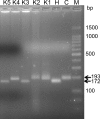Identification, molecular characterization, and occurrence of two bovine hemoplasma species in Swiss cattle and development of real-time TaqMan quantitative PCR assays for diagnosis of bovine hemoplasma infections
- PMID: 20686093
- PMCID: PMC2953077
- DOI: 10.1128/JCM.02224-09
Identification, molecular characterization, and occurrence of two bovine hemoplasma species in Swiss cattle and development of real-time TaqMan quantitative PCR assays for diagnosis of bovine hemoplasma infections
Abstract
Concomitantly with an outbreak of fatal anaplasmosis in a cattle herd in Switzerland in 2002, we detected two bovine hemoplasma species in diseased animals: Mycoplasma wenyonii (formerly Eperythrozoon wenyonii) and a second, novel bovine hemoplasma species later designated "Candidatus Mycoplasma haemobos" (synonym, "Candidatus Mycoplasma haemobovis"). The second species was characterized by a shorter 16S rRNA gene. The aims of the present study were to provide a detailed molecular characterization of this species, to develop specific quantitative real-time PCR assays for the two bovine hemoplasma species, and to apply these assays in order to evaluate the prevalence and clinical significance of the hemoplasmas. Sequencing of the near-complete 16S rRNA gene of the second hemoplasma revealed that it was 94% identical to that of Mycoplasma haemofelis, an anemia-inducing feline hemoplasma species, but less than 85% identical to that of the bovine hemoplasma M. wenyonii. Using the newly developed assays, a total of 159 animals from the anaplasmosis outbreak were reexamined. In addition, we tested 57 clinically ill and 61 healthy Swiss cattle, as well as 47 calves. Both hemoplasmas were highly prevalent in adult cattle but occurred rarely in calves. Animals from the herd with the fatal anemia outbreak were more frequently infected with M. wenyonii and exhibited higher M. wenyonii blood loads than animals with unrelated diseases and healthy animals. Coinfections may increase the pathogenicity and clinical significance of bovine hemoplasmosis.
Figures



Similar articles
-
First molecular evidence of bovine hemoplasma species (Mycoplasma spp.) in water buffalo and dairy cattle herds in Cuba.Parasit Vectors. 2019 Feb 7;12(1):78. doi: 10.1186/s13071-019-3325-y. Parasit Vectors. 2019. PMID: 30732656 Free PMC article.
-
Molecular detection of Mycoplasma wenyonii and its closely related hemotropic Mycoplasma sp. in blood-sucking flies from a buffalo farm in Chachoengsao province, Thailand.Acta Trop. 2022 Nov;235:106647. doi: 10.1016/j.actatropica.2022.106647. Epub 2022 Aug 9. Acta Trop. 2022. PMID: 35961407
-
First molecular evidence of bovine hemoplasmas in houseflies (Musca domestica).BMC Vet Res. 2024 Oct 30;20(1):497. doi: 10.1186/s12917-024-04343-x. BMC Vet Res. 2024. PMID: 39478614 Free PMC article.
-
From Haemobartonella to hemoplasma: molecular methods provide new insights.Vet Microbiol. 2007 Dec 15;125(3-4):197-209. doi: 10.1016/j.vetmic.2007.06.027. Epub 2007 Jul 7. Vet Microbiol. 2007. PMID: 17706380 Review.
-
A case of mistaken identity: a systematic review, meta-analysis, and reinvestigation of hemotropic Mycoplasma spp. infection in Ctenocephalides felis (cat flea).Parasit Vectors. 2024 May 9;17(1):209. doi: 10.1186/s13071-024-06292-8. Parasit Vectors. 2024. PMID: 38720359 Free PMC article.
Cited by
-
Advances in the Study of the Tick Cattle Microbiota and the Influence on Vectorial Capacity.Front Vet Sci. 2021 Aug 17;8:710352. doi: 10.3389/fvets.2021.710352. eCollection 2021. Front Vet Sci. 2021. PMID: 34485437 Free PMC article. Review.
-
Complete genome sequence of Mycoplasma wenyonii strain Massachusetts.J Bacteriol. 2012 Oct;194(19):5458-9. doi: 10.1128/JB.01240-12. J Bacteriol. 2012. PMID: 22965086 Free PMC article.
-
Molecular detection of haemophilic pathogens reveals evidence of Candidatus Mycoplasma haemobos in dogs and parasitic ticks in central China.BMC Vet Res. 2022 Jul 1;18(1):254. doi: 10.1186/s12917-022-03361-x. BMC Vet Res. 2022. PMID: 35778709 Free PMC article.
-
Occurrence of 'Candidatus Mycoplasma haemosuis' in fattening pigs, sows and piglets in Germany using a novel gap-based quantitative real-time PCR assay.BMC Vet Res. 2022 Jan 17;18(1):40. doi: 10.1186/s12917-022-03147-1. BMC Vet Res. 2022. PMID: 35039068 Free PMC article.
-
Coinfection of Bovine ephemeral fever virus and 'Candidatus Mycoplasma haemobos' in cattle in Central China: implications for tick-borne transmission and viral divergence.BMC Vet Res. 2025 Jul 12;21(1):460. doi: 10.1186/s12917-025-04917-3. BMC Vet Res. 2025. PMID: 40646593 Free PMC article.
References
-
- Adler, S., and V. Ellenbogen. 1934. A note on two new blood parasites of cattle, Eperythrozoon and Bartonella. J. Comp. Pathol. Ther. 47:219-221.
-
- Berent, L. M., J. B. Messick, and S. K. Cooper. 1998. Detection of Haemobartonella felis in cats with experimentally induced acute and chronic infections, using a polymerase chain reaction assay. Am. J. Vet. Res. 59:1215-1220. - PubMed
-
- Donatien, A., and F. Lestoquard. 1934. Sur une Bartonella nouvelle du boeuf, Bartonella bovis n. sp. Bull. Soc. Pathol. Exot. 27:652-654.
-
- Foley, J. E., S. Harrus, A. Poland, B. Chomel, and N. C. Pedersen. 1998. Molecular, clinical, and pathologic comparison of two distinct strains of Haemobartonella felis in domestic cats. Am. J. Vet. Res. 59:1581-1588. - PubMed
-
- Hofmann-Lehmann, R., M. L. Meli, U. M. Dreher, E. Gonczi, P. Deplazes, U. Braun, M. Engels, J. Schupbach, K. Jorger, R. Thoma, C. Griot, K. D. Stark, B. Willi, J. Schmidt, K. M. Kocan, and H. Lutz. 2004. Concurrent infections with vector-borne pathogens associated with fatal hemolytic anemia in a cattle herd in Switzerland. J. Clin. Microbiol. 42:3775-3780. - PMC - PubMed
Publication types
MeSH terms
Substances
Associated data
- Actions
- Actions
LinkOut - more resources
Full Text Sources
Molecular Biology Databases

